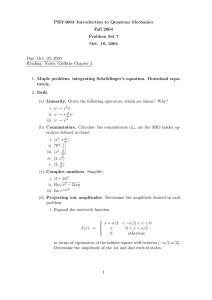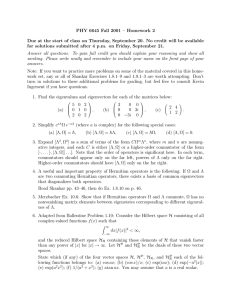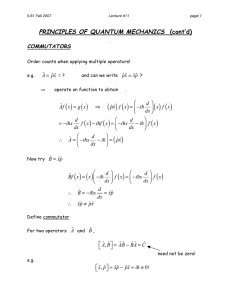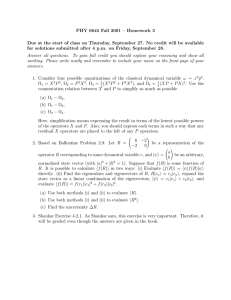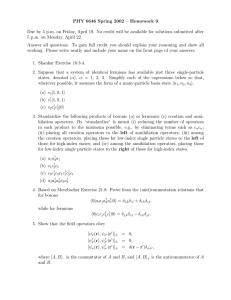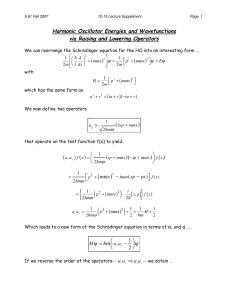Phy4604 Quantum Mechanics I Math practice I Peter Hirschfeld Fall 2004
advertisement
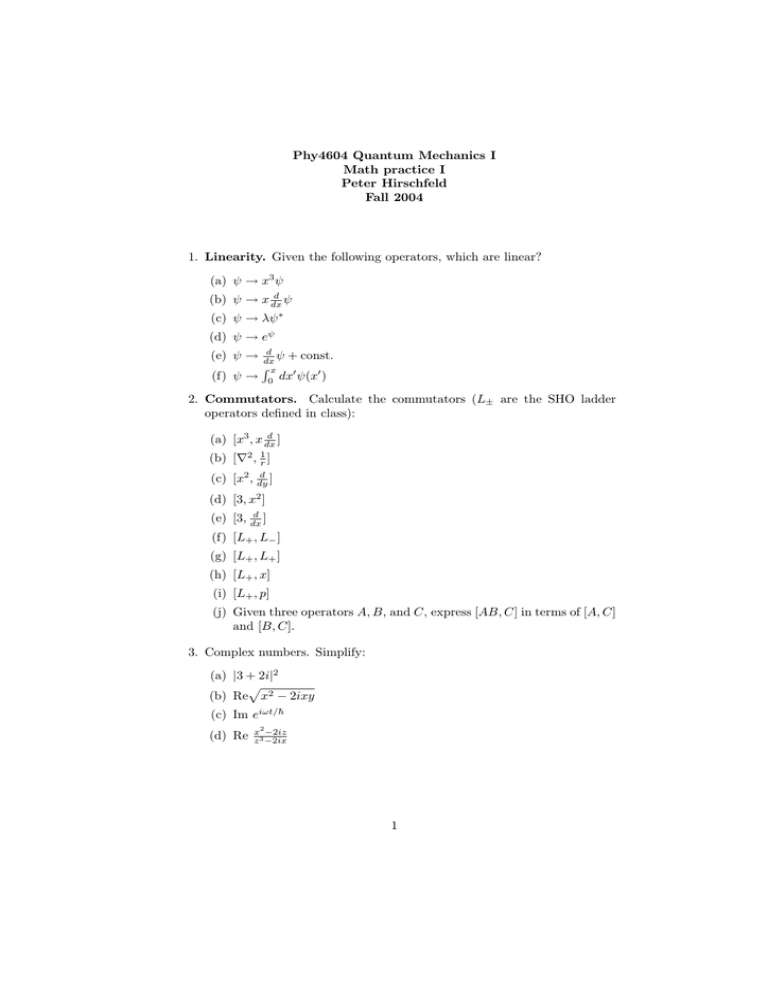
Phy4604 Quantum Mechanics I Math practice I Peter Hirschfeld Fall 2004 1. Linearity. Given the following operators, which are linear? (a) ψ → x3 ψ d (b) ψ → x dx ψ (c) ψ → λψ ∗ (d) ψ → eψ d dx ψ + const. Rx 0 (f) ψ → 0 dx ψ(x0 ) (e) ψ → 2. Commutators. Calculate the commutators (L± are the SHO ladder operators defined in class): d (a) [x3 , x dx ] (b) [∇2 , 1r ] d ] (c) [x2 , dy (d) [3, x2 ] d (e) [3, dx ] (f) [L+ , L− ] (g) [L+ , L+ ] (h) [L+ , x] (i) [L+ , p] (j) Given three operators A, B, and C, express [AB, C] in terms of [A, C] and [B, C]. 3. Complex numbers. Simplify: (a) |3 + 2i|2 p (b) Re x2 − 2ixy (c) Im eiωt/h̄ (d) Re x2 −2iz z 3 −2ix 1 4. Fourier transform. For these problems assume the asymmetric normalization of the Fourier transform: Z f (x) = g(k)eikx g(k) = = 1 f (x)e−ikx 2π Try to do each of these analytically, then check with Maple. Hint: some may be easier if you use contour integration. (a) f (x) = “window” function of width a, ½ f0 |x| < a/2 f (x) = 0 |x| > a/2 g(k) =? (b) f (x) = Gaussian exp(−x2 /(2σ 2 ), g(k)= ? (c) f (x) = A exp(−a|x|), g(k) =? (d) Lorentzian f (x) = A (x2 +a2 ) , g(k) =? 5. Projecting out amplitudes. Determine the amplitude desired in each problem: (a) Expand window function above in 1D SHO eigenfunctions. What is the amplitude of the 1st excited state? (b) Expand the sawtooth function f (x) x + a/2 < −a/2 < x < 0 x 0 < x < a/2 = 0 otherwise in terms of eigenstates of the infinite square well between (−a/2, a/2). Determine the amplitude of the 1st and 2nd excited states. 6. Delta functions. Evaluate: R3 1 2 (a) −3 dx δ(x − 2) exp− 2 x R3 1 2 (b) −3 dx δ(x − 4) exp− 2 x R (c) d3 r eik·r e−ik·r R (d) d3 r eiak·r e−ibk·r 7. Inner products. 2 (a) Simplify (αA + βB, γC + δD), where Greek letters are complex constants and Roman letters are operators. (b) Evaluate (ψ0 , x2 ψ2 ) for SHO wavefunctions. (c) Evaluate (ψ1 , x2 ψ2 ) for SHO wavefunctions. 8. Hermitian operators. Let x and p be the usual operators for position and momentum. State whether each of the following operators is selfadjoint (Hermitian), anti-self-adjoint (antiHermitian, O† = −O), unitary (O† O = 1), or if none of the above, what the adjoint is. Hint: remember (AB)† = B † A† . (a) xxp (b) xpx (c) xpp + ppx (d) d2 dx2 (e) d3 dx3 p (f) e 9. More operators. Two operators A and B satisfy A = B † B + 3 and A = BB † + 1. (a) show A is self-adjoint (b) find [B † , B] (c) find [A, B] (d) Suppose ψ is an eigenfunction of A with eigenvalue α. Show that if Bψ 6= 0, then Bψ is an eigenfunction of A, and find the eigenvalue. 10. Gram-Schmidt. The Legendre polynomials P` (x) are a set of real polynomials orthogonal to each other on the interval −1 < x < 1: Z 1 dxP` (x)P`0 (x) = δ`,`0 . −1 The polynomial P` is of order `, i.e. the highest power of x is x` . Starting with the set of functions ψ` (x) = x` , use the Gram-Schmidt procedure to construct P0 (x), P1 (x), and P2 (x). 3
